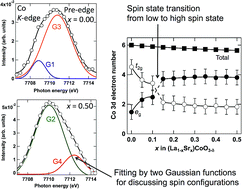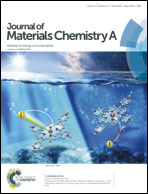Correlation between structure and mixed ionic–electronic conduction mechanism for (La1−xSrx)CoO3−δ using synchrotron X-ray analysis and first principles calculations†
Abstract
The mechanism of mixed ionic–electronic conduction (MIEC) for (La1−xSrx)CoO3−δ (LSC) (x = 0.00–0.50) was investigated by experimental as well as theoretical studies which included Rietveld refinements, maximum entropy method (MEM) analysis, X-ray absorption spectroscopy, and first principles calculations (FPCs). The correlations among MIEC, structural parameters, i.e., the bond length, the bond angle, electron density, and the spin configuration, were discussed from the practical results. Moreover, these correlations were verified by FPC, and interpreted by the band structure and the total energy of LSC. The electronic conductivity was affected by the Co–O–Co bond angle, electron densities, and the spin state. In particular, the spin transition from the low to high spin state was accompanied by the cross-over from semiconductor to metallic at x = 0.15. Concerning the oxide ion diffusion, LSC has large anisotropic atomic displacement parameters of the oxide ion sites, in the vertical direction of the Co–O bond, which associate with the high oxide ion diffusion. The total energy of LSC during the migration of the oxide ion was also calculated with varying Sr content, lattice parameters, and symmetries by using FPC. Consequently, the symmetry of LSC is more effective to reduce the activation energy of oxide ion diffusion than Sr content and lattice parameters.


 Please wait while we load your content...
Please wait while we load your content...